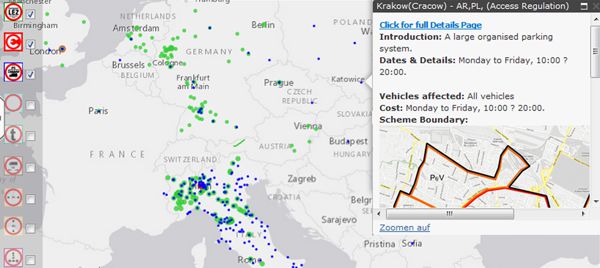EU: Low Emission Zones (LEZ)
Background
Low Emission Zones (LEZ) are areas—usually within cities and larger towns—with various restrictions on the operation of more polluting, typically older vehicles. Cities and governments have been adopting LEZ programs as a measure to reduce ambient exposures to air pollution, to meet the EU Air Quality Standards. Low Emission Zones are often considered the most effective measure that towns and cities can take to improve air quality. Low Emission Zones can reduce emissions of fine particles, nitrogen dioxide and (indirectly) ozone, the three main air pollutants of concern in Europe.
The Environmental Zones started in Sweden in 1996 can be considered the first LEZ program. Following the Swedish example, Low Emission Zones were implemented in a few cities in Germany, the Netherlands, north Italy, as well as London in 2007-2008. Since then the number of LEZs has been steadily increasing and they now exist in many EU countries.
Comprehensive information on Low Emission Zones can be found on urbanaccessregulations.eu The website also covers other types of vehicle access restrictions, such as congestion charging or permit access schemes across the European Union.

Low Emission Zones are also known as Environment Zones, Umweltzonen, Milieuzones, Lavutslippssone, Miljozone, Miljözon or ZTL ambiente.
Typical Requirements
Low Emission Zones are geographical areas where the most polluting vehicles are regulated. Usually this means that vehicles with higher emissions cannot enter the area. In some Low Emission Zones the more polluting vehicles have to pay a higher fee/toll if they enter the low emission zone. LEZ requirements are not harmonized across the EU—rather, the particular LEZs are governed by different, local and/or country level regulations.
Typical LEZ requirements include:
- A ban on higher emission vehicles—Vehicles below a certain EU emission level are not allowed to enter the LEZ. For example, only Euro 4 and later vehicles may be allowed, while Euro 3 and older vehicles cannot enter the zone. Some LEZs have different standards for petrol and diesel to account for the different emissions of PM and NO2. In Germany, it is Euro 1 for petrol, and Euro 3 or Euro 4 for diesel. In London, the 2020 standards are Euro 4 for petrol and Euro 6 for diesel.
- Retrofit options—Vehicles’ emission ratings can be upgraded by a retrofit with an emission control device, such as a diesel particulate filter (DPF). For example, a Euro 3 vehicle retrofitted with a DPF may be considered equivalent to a Euro 4 vehicle in the zone.
- Charging schemes—Higher emission vehicles may be charged a fee to enter the zone, while vehicles meeting a certain minimum Euro level enter for free.
LEZ requirements may be applicable to heavy vehicles, light-duty vehicles, or both light and heavy vehicles. Most LEZs operate 24 hours a day, 365 days a year (except some of the Italian LEZs which are not in operation permanently). Low emission zones are enforced either with camera systems or manually, usually together with windscreen stickers. In some zones, it is necessary to register or buy a sticker before entering. In most zones, foreign vehicles are affected as well as national vehicles.
The scope of LEZ programs for selected regions are listed in Table 1. More details on the requirements can be found on urbanaccessregulations.eu.
| Country or Region | LEZ Scope |
|---|---|
| Austrian LEZs | Lorries over 3.5 t, stickers required, some retrofit options |
| Belgium | All vehicles with four and more wheels (planned), retrofit options |
| Czech Republic | Lorries over 3.5 t or 6 t, stickers required |
| Denmark | All diesel-powered vehicles above 3.5 t, stickers required, retrofit options |
| Finland | Buses and garbage trucks (dustbin lorries) |
| Germany | All vehicles with four wheels, stickers required, retrofit options |
| Greece | All vehicles, vehicles over or under 2.2 t |
| Italy | All vehicles, including mopeds and motorcycles |
| Italy/France, Mont Blanc tunnel | Lorries only, control at tunnel entry |
| Netherlands | Lorries over 3.5 t GVW, camera enforced |
| Norway | All vehicles (planned), transponder enforced |
| Portugal | Petrol & diesel, light -duty and heavy-duty |
| Sweden | All heavy, diesel-powered trucks and buses, stickers required |
| UK, London | Vans and similar over 1.205 t unladen, and vehicles over 3.5 t GVW, camera enforced, foreign vehicles need to register |
| UK outside London | Public service buses only, retrofit options. |
Retrofit devices used in LEZs need to be certified. The certification is conducted at the country level and most countries maintain a list of certified devices. Since 2014, the UNECE Working Party on Pollution and Energy (GRPE) has been developing a Retrofit Emission Control devices (REC) certification scheme, which European countries can use as the basis of their national schemes.